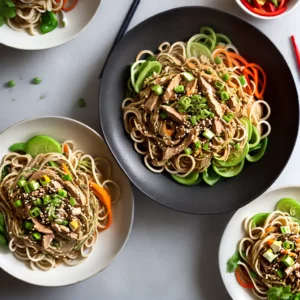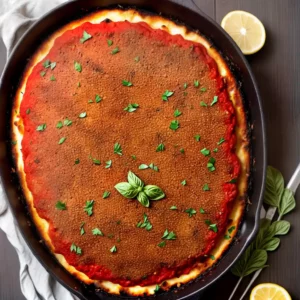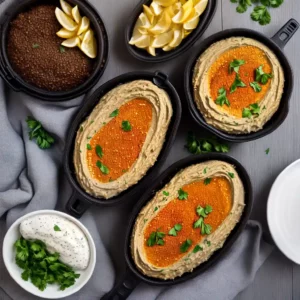Welcome to my guide on how to store chicken safely. As a food safety enthusiast, I understand the importance of proper chicken storage to prevent the growth of bacteria and foodborne illnesses. In this article, I will provide you with helpful tips and guidelines to ensure your chicken stays fresh and safe to consume.
Key Takeaways:
- Properly storing chicken is crucial for food safety.
- Refrigerate fresh raw chicken at a temperature below 40°F.
- Freeze raw chicken for long-term storage.
- Cooked chicken should be refrigerated promptly after cooking.
- Follow best practices for raw chicken storage to prevent contamination.
Refrigeration for Fresh Raw Chicken
When it comes to storing fresh raw chicken, refrigeration is key. Maintaining the right temperature is crucial to ensure the quality and safety of the chicken. Fresh raw chicken, including chicken parts, chicken sausages, giblets, ground chicken, and whole chicken, should be stored in the refrigerator at a temperature below 40°F (4°C).
It is recommended to store fresh raw chicken in the refrigerator for 1 to 2 days. This ensures that the chicken stays fresh and reduces the risk of bacterial growth. After the recommended storage period, if you’re not planning to use the chicken, it’s best to freeze it for long-term storage.
By refrigerating raw chicken properly, you can preserve its freshness and ensure that it remains safe to consume. Remember to always check the expiration date and follow the recommended storage guidelines based on the type of chicken you have.
Table: Recommended Refrigeration Times for Fresh Raw Chicken
| Type of Chicken | Refrigeration Time |
|---|---|
| Chicken Parts | 1-2 days |
| Chicken Sausages | 1-2 days |
| Giblets | 1-2 days |
| Ground Chicken | 1-2 days |
| Whole Chicken | 1-2 days |
By following proper refrigeration practices, you can keep your fresh raw chicken at its best, ensuring its quality and minimizing the risk of foodborne illnesses.
Freezing Raw Chicken
When it comes to storing raw chicken for an extended period, freezing is the best option. Freezing not only helps to preserve the freshness of the chicken but also prevents the growth of bacteria. To freeze raw chicken, it’s important to follow a few simple steps to ensure optimal results.
Proper Packaging
Firstly, it’s essential to properly package the raw chicken before freezing. This helps to prevent freezer burn and maintain the quality of the chicken. Wrap individual pieces of chicken, such as chicken patties or individually quick frozen chicken breasts, in foil or plastic bags. Then, place the wrapped pieces in a larger freezer bag or wrap to provide an extra layer of protection.
Storage Duration
Raw chicken can be stored in the freezer for an average of 3 to 4 months, depending on the type. It’s important to check the packaging or label for specific guidelines regarding storage duration. However, it’s generally recommended to consume frozen chicken within a reasonable time frame to ensure optimal taste and quality.
Thawing Frozen Chicken
When it’s time to use the frozen chicken, it’s important to thaw it properly to maintain its flavor and texture. The recommended method for thawing frozen chicken is to transfer it from the freezer to the refrigerator and allow it to thaw slowly overnight. This gradual thawing process helps to prevent the growth of bacteria. Avoid thawing chicken at room temperature, as it can lead to bacterial contamination.
| Type of Chicken | Storage Duration in Freezer |
|---|---|
| Chicken Patties | 3 to 4 months |
| Individually Quick Frozen Chicken Breasts | 3 to 4 months |
By following these guidelines for freezing raw chicken, you can ensure that your chicken remains safe and delicious for future use.
Storage of Cooked Chicken
Once chicken is cooked, it’s important to store it properly to maintain its quality and prevent any foodborne illnesses. Whether it’s leftovers from a meal or cooked chicken parts, following the right storage guidelines is crucial. Here are some tips for storing cooked chicken:
Refrigeration:
Once your cooked chicken has cooled down, place it in an airtight container or wrap it tightly in plastic wrap. Refrigerate the chicken promptly to keep it at a safe temperature.
Shelf Life:
Cooked chicken should be consumed or used within 3 to 4 days of refrigeration. After this time, it’s best to discard it to avoid any potential health risks.
Freezing:
If you have a large amount of cooked chicken that you won’t be able to consume within a few days, freezing is a great option. Wrap the chicken tightly in freezer-safe bags or containers, removing as much air as possible to prevent freezer burn. Label the packaging with the date to keep track of its freshness. Cooked chicken can be safely stored in the freezer for 4 to 6 months.
Variety of Cooked Chicken:
It’s important to note that the storage times for different cooked chicken dishes may vary. For example, fried chicken or other cooked chicken dishes that contain breadcrumbs or coatings may have a shorter shelf life in the refrigerator compared to plain cooked chicken parts or whole roasted chicken. Always use your best judgment and don’t hesitate to discard cooked chicken if it shows signs of spoilage.
By following these guidelines, you can ensure the safe and proper storage of cooked chicken. Remember to always practice good food hygiene and use your senses to determine if the chicken is still fresh and safe to consume.
Best Practices for Raw Chicken Storage
When it comes to storing raw chicken, following best practices is essential to ensure food safety and prevent contamination. By implementing proper refrigeration and storage techniques, you can minimize the risk of harmful bacteria growth and cross-contamination. Here are some important guidelines to keep in mind:
Refrigeration
Refrigeration is key to maintaining the freshness of raw chicken. Store it in the coldest part of your refrigerator, typically on the bottom shelf, to prevent any drippage onto other food items. This will help avoid cross-contamination. Remember to keep raw chicken away from ready-to-eat foods. Tightly wrap the chicken in plastic or place it in sealed containers to prevent its juices from spreading.
Temperature
Keep your refrigerator temperature at or below 40°F to slow down bacterial growth. By maintaining the ideal temperature, you create an inhospitable environment for bacteria. Regularly check your refrigerator’s temperature to ensure it is within the safe range.
Storage Duration
It’s important to store raw chicken for the appropriate amount of time. Generally, it is recommended to use fresh raw chicken within 1 to 2 days of refrigeration. If you are unable to use it within that timeframe, freezing is a good option for long-term storage.
| Type of Raw Chicken | Refrigeration Duration | Freezing Duration |
|---|---|---|
| Chicken Parts (sliced, cut, etc.) | 1 to 2 days | 9 to 12 months |
| Whole Chicken | 1 to 2 days | 1 year |
| Giblets | 1 to 2 days | 3 to 4 months |
| Ground Chicken | 1 to 2 days | 3 to 4 months |
| Chicken Sausages | 1 to 2 days | 2 to 3 months |
By following these best practices for raw chicken storage, you can ensure that your chicken remains safe to consume and maintains its quality. Prioritize proper refrigeration, temperature control, and storage durations to minimize the risk of contamination and enjoy delicious chicken dishes with peace of mind.
Proper Handling of Raw Chicken
When it comes to raw chicken, proper handling is essential to maintain food safety and prevent the spread of harmful bacteria. Following these guidelines will help ensure that you handle raw chicken in a hygienic manner.
Key Points:
- Wash your hands thoroughly with hot, soapy water before and after handling raw chicken. This step is crucial in preventing the transfer of bacteria.
- Use separate cutting boards and utensils for raw chicken to avoid cross-contamination. It’s recommended to have designated cutting boards solely for raw poultry to prevent the spread of bacteria to other foods.
- After using cutting boards and utensils for raw chicken, clean them with hot, soapy water to eliminate any bacteria. If possible, sanitize them with a mild bleach solution to ensure thorough disinfection.
- Never allow raw chicken to come into contact with ready-to-eat foods. This includes keeping raw chicken separate from vegetables, fruits, cooked meals, and other items that won’t undergo further cooking.
- If raw chicken juices come into contact with countertops, utensils, or any surfaces, promptly clean and sanitize them to prevent bacterial contamination.
Remember, practicing good hygiene and proper handling techniques when dealing with raw chicken is crucial for ensuring food safety and preventing foodborne illnesses.
By following these guidelines, you can minimize the risk of contamination and keep yourself and your loved ones safe from harmful bacteria that may be present in raw chicken.
| Common Mistakes | Tips |
|---|---|
| Touching other foods or surfaces with hands contaminated by raw chicken | Wash hands thoroughly with hot, soapy water before and after handling raw chicken |
| Using the same cutting board and utensils for raw chicken and other foods | Use separate cutting boards and utensils exclusively for raw chicken |
| Allowing raw chicken juices to come into contact with ready-to-eat foods | Keep raw chicken separate from other foods to prevent cross-contamination |
| Not properly cleaning and sanitizing surfaces and utensils after handling raw chicken | Clean surfaces and utensils with hot, soapy water, and sanitize if possible |
Importance of Freshness and Expiration Dates
When it comes to storing chicken, maintaining freshness is crucial for both quality and safety. Understanding expiration dates and the shelf life of chicken is essential to ensure you are consuming fresh and healthy poultry.
Proper storage and handling techniques are vital in order to preserve the freshness of raw chicken. The freshness of chicken can be determined by its smell and texture. If the chicken has a foul odor or slimy texture, it is likely spoiled and should be discarded immediately.
“Proper storage and handling techniques are vital in order to preserve the freshness of raw chicken.”
Expiration dates play a significant role in determining the freshness and viability of chicken products. These dates provide a guideline for when the chicken should be consumed by, ensuring that it is still safe to eat. It is important to pay attention to these dates and consume the chicken before they expire.
By adhering to proper storage guidelines, including refrigeration at the appropriate temperature and maintaining good hygiene practices, you can extend the shelf life of chicken and enjoy it at its best quality. It is always better to be cautious and prioritize freshness to ensure a safe and enjoyable dining experience.
| Type of Chicken | Refrigeration Shelf Life | Freezing Shelf Life |
|---|---|---|
| Whole Chicken | 1-2 days | 1 year |
| Chicken Parts (Breasts, Thighs, Drumsticks) | 1-2 days | 9 months |
| Ground Chicken | 1-2 days | 4 months |
| Chicken Patties | 1-2 days | 4 months |
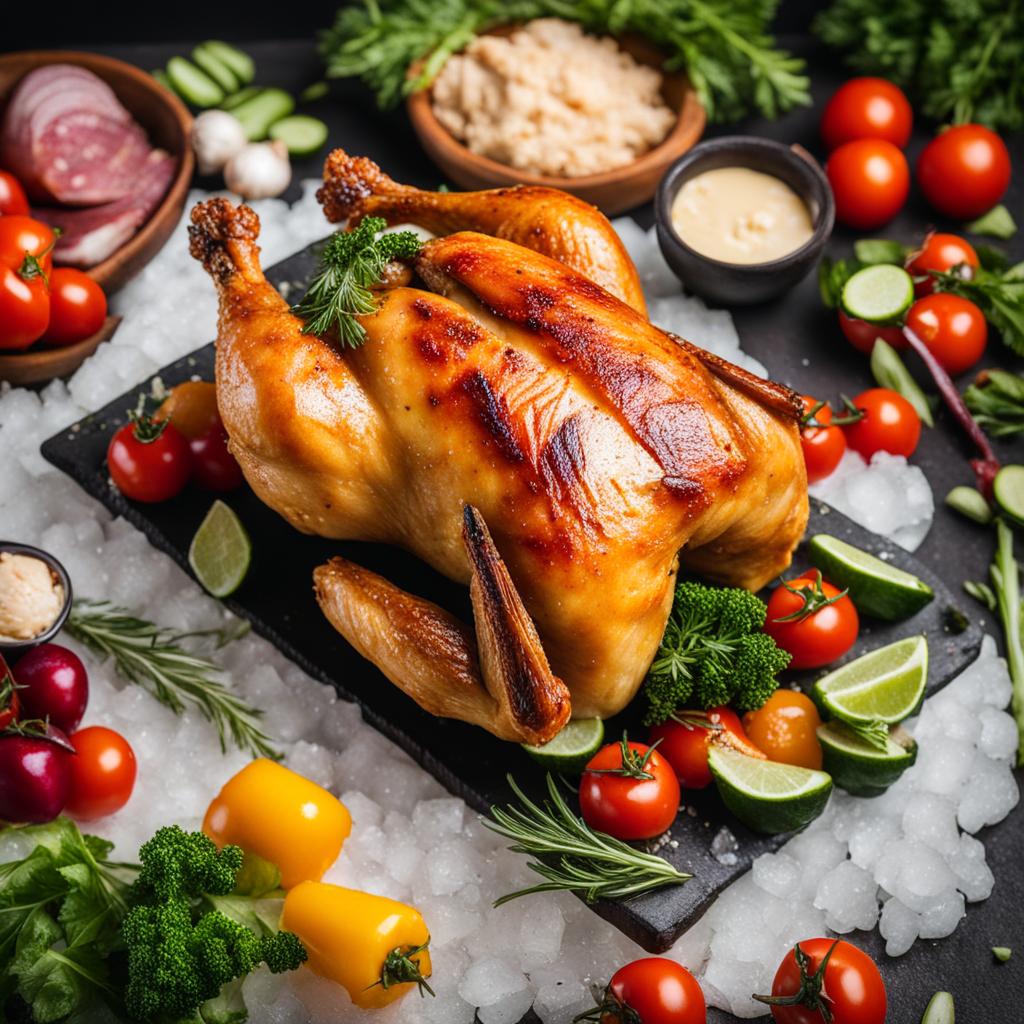
The Importance of Proper Storage
Storing chicken properly is crucial to maintain its freshness and to prevent the growth of harmful bacteria. Proper refrigeration and freezing techniques, as well as attention to expiration dates, help ensure that your chicken stays safe to consume. By following these guidelines, you can enjoy fresh and delicious chicken while prioritizing food safety.
Freezing Tips for Raw Chicken
When it comes to storing raw chicken, freezing is a great option to extend its shelf life. By following these freezing tips, you can ensure the quality and safety of your chicken:
- Freeze in small portions: Instead of freezing an entire package of raw chicken, divide it into smaller portions. This makes it easier to thaw only what you need and reduces the risk of bacterial growth during thawing.
- Fast freezing: Flatter and smaller wrapped chicken freezes faster. This helps to preserve the quality of the chicken and prevents the growth of bacteria. Spread the chicken pieces in a single layer on a baking sheet and place them in the freezer until they are partially frozen. Then, transfer them to a freezer bag or airtight container for long-term storage.
By freezing raw chicken in small portions and using the fast freezing method, you can ensure that your chicken stays fresh and safe for future use.
| Item | Recommended Storage Time |
|---|---|
| Chicken parts (breasts, thighs, etc.) | Up to 9 months |
| Ground chicken | Up to 4 months |
| Chicken patties or nuggets | Up to 3 months |
| Whole chicken | Up to 1 year |
Here is a table summarizing the recommended storage times for different types of raw chicken when properly frozen:
“By freezing raw chicken in small portions and using the fast freezing method, you can ensure that your chicken stays fresh and safe for future use.”
Storing Cooked Chicken Safely
After cooking delicious chicken, it is essential to store it safely to prevent bacterial growth and ensure food safety. Leaving cooked chicken on the countertop for too long can create the perfect environment for bacteria to multiply rapidly. To maintain the quality and freshness of your cooked chicken, it is crucial to follow proper storage practices and adhere to safe temperature guidelines.
The key to storing cooked chicken safely is refrigeration. After cooking, don’t leave cooked chicken at room temperature for more than two hours. Promptly place the chicken in the refrigerator to minimize bacterial growth. It is recommended to store cooked chicken in the refrigerator loosely covered for the first couple of hours to allow it to cool quickly.
When storing cooked chicken in the refrigerator, keep in mind that it should be consumed within 3 to 4 days. After this time, it is advisable to freeze the chicken to extend its shelf life. Freezing cooked chicken in an airtight container can maintain its quality for 4 to 6 months.
| Safe Storage Tips for Cooked Chicken |
|---|
| Refrigerate cooked chicken promptly after cooking |
| Store cooked chicken in the refrigerator loosely covered for the first couple of hours |
| Consume cooked chicken within 3 to 4 days when refrigerated |
| Freeze cooked chicken in an airtight container for extended storage |
| Thaw frozen cooked chicken in the refrigerator or using the defrost setting on the microwave before reheating |
| Reheat cooked chicken to an internal temperature of 165°F |
By following these guidelines for storing cooked chicken safely, you can ensure its quality, reduce wastage, and protect yourself and your family from potential foodborne illnesses.
Proper Storage Containers for Raw Chicken
When it comes to storing raw chicken, using the right storage containers is crucial to maintain freshness and prevent contamination. Airtight and sealed containers are highly recommended to ensure that the chicken remains safe to consume. Here are some popular options:
- Ziplock Bags: These versatile bags are perfect for storing individual portions of raw chicken. They provide a tight seal to keep the chicken fresh and prevent any leaks or spills in the refrigerator or freezer.
- Freezer Bags: Similar to ziplock bags, freezer bags are designed specifically for freezing food. They are thicker and more durable, making them ideal for long-term storage of raw chicken in the freezer.
- Cling Wrap: Wrapping raw chicken tightly in cling wrap helps to minimize exposure to air and potential contamination. It provides a barrier that prevents moisture loss and maintains the chicken’s quality.
- Aluminum Foil: Another option for wrapping raw chicken is aluminum foil. It offers similar benefits to cling wrap, creating a protective barrier against air and moisture.
By using these storage containers, you can ensure that your raw chicken stays fresh and safe to consume. Remember to label and date the packages for easy identification and rotation. It’s also important to keep in mind that these containers should be used exclusively for storing raw chicken to avoid cross-contamination.
| Storage Container | Advantages |
|---|---|
| Ziplock Bags | Provides a tight seal, convenient for portioning |
| Freezer Bags | Thicker and more durable, suitable for long-term freezing |
| Cling Wrap | Minimizes exposure to air, maintains moisture and quality |
| Aluminum Foil | Creates a protective barrier against air and moisture |
Using the right storage containers for raw chicken is an essential part of practicing proper food safety. Whether you opt for ziplock bags, freezer bags, cling wrap, or aluminum foil, ensure that the containers are airtight and sealed to maintain the freshness and quality of the chicken.
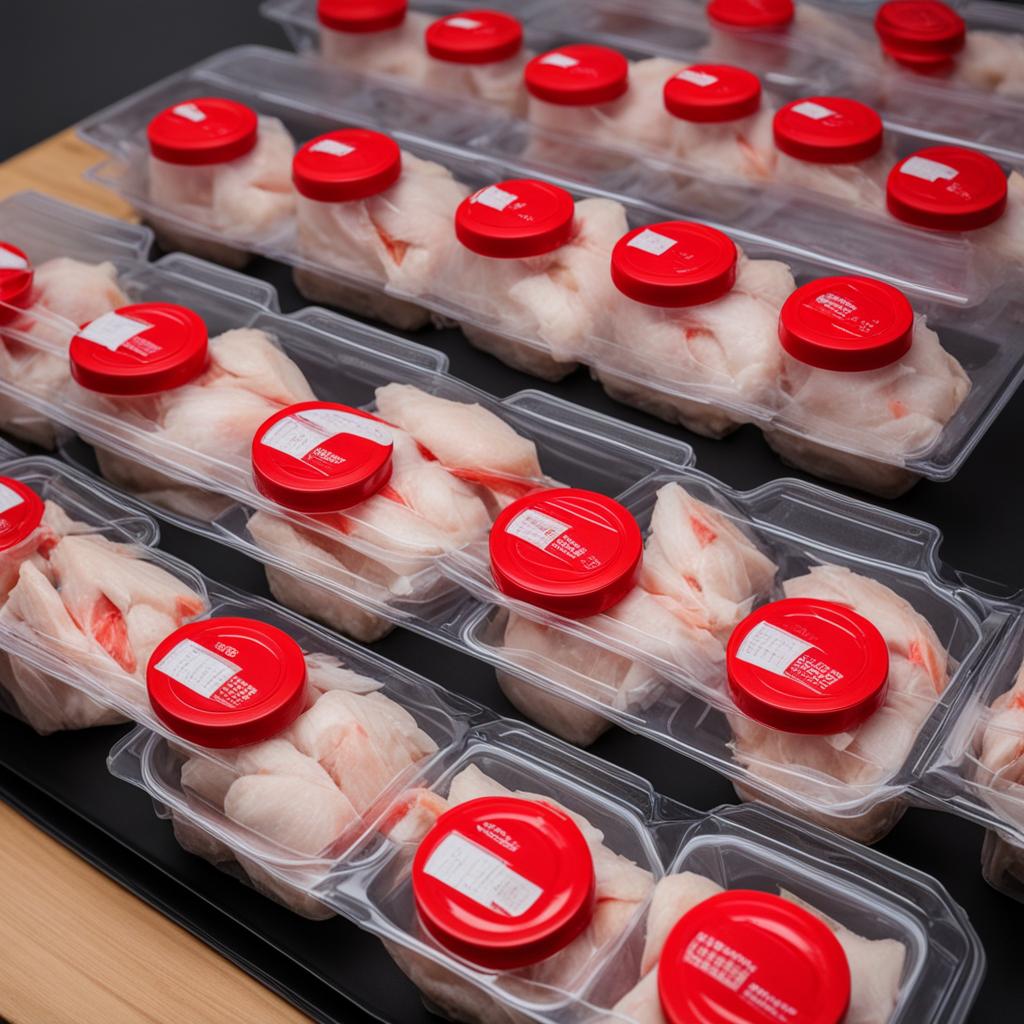
Ideal Temperatures for Chicken Storage
When it comes to storing chicken, maintaining the ideal temperatures is crucial to ensure its freshness and prevent the growth of harmful bacteria. Proper storage in the refrigerator and freezer is essential to keep your chicken safe for consumption. Here are the recommended temperatures for storing chicken:
Refrigerator Temperature:
- Keep your refrigerator temperature at or below 40°F (4°C) to slow down bacterial growth in raw chicken.
- Place raw chicken on the bottom shelf of the refrigerator to prevent any drippage onto other foods and cross-contamination.
Freezer Temperature:
- Maintain your freezer temperature at or below 0°F (-18°C) to ensure the optimal storage of both raw and cooked chicken.
- Freezing chicken at this temperature helps to preserve its quality and prevent the growth of bacteria.
By following these temperature guidelines, you can keep your chicken safe and maintain its quality for longer periods. Whether you’re storing raw chicken in the refrigerator or freezing it for future use, ensuring the right temperatures will help safeguard against foodborne illnesses and keep your chicken delicious.
| Storage Method | Recommended Temperature |
|---|---|
| Refrigeration (Raw Chicken) | 40°F (4°C) or below |
| Freezing (Raw and Cooked Chicken) | 0°F (-18°C) or below |
By understanding the ideal temperatures for chicken storage, you can ensure the safety and quality of your poultry. Remember to regularly check and adjust your refrigerator and freezer temperatures to maintain optimal conditions. By following proper storage practices, you can enjoy delicious and safe chicken meals with peace of mind.
Proper Thawing and Defrosting Techniques
Thawing frozen chicken correctly is essential for maintaining the quality and safety of the meat. Here are some recommended techniques to defrost chicken safely:
- Refrigerator Thawing: The best and safest way to thaw chicken is by placing it in the refrigerator. Take the frozen chicken out of the freezer and place it in a covered container or on a tray to catch any drips. Allow the chicken to thaw in the refrigerator for several hours or overnight, depending on the size and thickness of the pieces. This method ensures a gradual thawing process, keeping the chicken at a safe temperature and minimizing the risk of bacterial growth.
- Microwave Thawing: If you need to defrost chicken quickly, you can use the defrost setting on your microwave. Make sure to follow the manufacturer’s instructions for thawing meat. Use microwave-safe containers or packaging, and turn the chicken periodically to ensure even thawing. Once thawed, cook the chicken immediately to prevent any bacterial growth that may have occurred during the microwave thawing process.
- Cold Water Thawing: If you’re short on time, you can thaw chicken using the cold water method. Place the chicken in a leak-proof plastic bag and submerge it in cold water. Change the water every 30 minutes to maintain a safe temperature. Thawing time varies depending on the size and packaging of the chicken, but a pound of chicken typically thaws in 1 to 2 hours. Once thawed, cook the chicken immediately.
Remember, never thaw chicken at room temperature, as it can promote the growth of harmful bacteria. Always cook thawed chicken immediately and avoid refreezing thawed chicken to maintain its quality and safety.
Proper Cooking of Thawed Chicken
After thawing chicken, it’s crucial to cook it thoroughly to ensure food safety. Chicken should reach an internal temperature of 165°F (74°C) to kill any bacteria that may be present. Use a food thermometer to check the temperature, inserting it into the thickest part of the meat without touching bone or fat.
Whether you’re grilling, baking, frying, or simmering chicken, make sure it reaches the recommended temperature for safe consumption. Proper cooking not only eliminates the risk of harmful bacteria but also ensures that the chicken is tender and juicy.
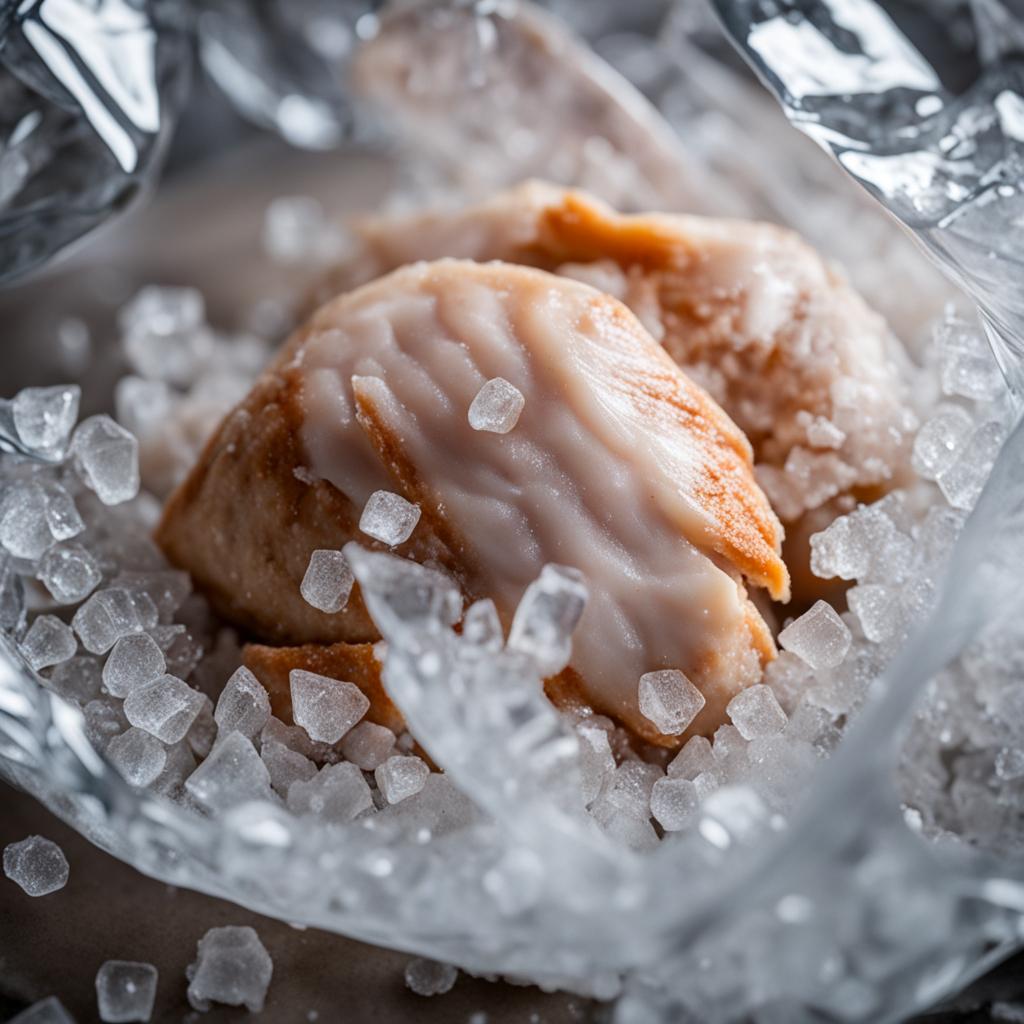
| Thawing Method | Thawing Time |
|---|---|
| Refrigerator Thawing | Several hours to overnight, depending on size |
| Microwave Thawing | Varies depending on size and microwave settings |
| Cold Water Thawing | 1 to 2 hours, changing water every 30 minutes |
Reheating Cooked Chicken
When it comes to reheating cooked chicken, it’s important to do so safely to avoid the risk of foodborne illnesses. The key is to make sure the chicken reaches a safe internal temperature throughout. The recommended safe temperature for reheating cooked chicken is 165°F.
To ensure that your reheated chicken reaches this temperature, it’s best to use a food thermometer. Insert the thermometer into the thickest part of the chicken to get an accurate reading. If the chicken has bones, make sure the thermometer does not touch the bone as it can give a false reading.
It’s also important to note that leftover reheated chicken should not be left at room temperature for more than 2 hours. Bacteria can grow rapidly at room temperature, increasing the risk of foodborne illnesses. If you have leftover reheated chicken that has been sitting out for longer than 2 hours, it’s best to discard it to ensure your safety.
| Safe Internal Temperature for Reheating Chicken |
|---|
| 165°F |
By reheating cooked chicken to the recommended safe temperature and following proper food safety guidelines, you can enjoy your leftovers without worrying about getting sick. Remember to always handle and store cooked chicken properly to maintain its quality and safety.
Tips for Maintaining Optimal Chicken Storage
When it comes to storing chicken, there are several guidelines you can follow to ensure optimal freshness, safety, and flavor. By implementing these storage tips, you can maintain the quality of both raw and cooked chicken, while also preventing any potential risks associated with improper storage.
Properly Store Raw and Cooked Chicken Separately
To minimize the risk of cross-contamination, it is vital to store raw and cooked chicken separately. Raw chicken should always be stored on the bottom shelf of the refrigerator to prevent any juices from dripping onto other foods. Additionally, use separate cutting boards and utensils for raw chicken to avoid spreading bacteria to other surfaces.
Check Expiration Dates and Label Freezer Packages
When purchasing chicken, always check the expiration dates to ensure its freshness. It is also important to label and date freezer packages to keep track of how long the chicken has been stored. This will help you avoid consuming chicken that is past its prime and maintain proper food safety.
Maintain Proper Hygiene and Kitchen Safety
Good hygiene practices play a crucial role in chicken storage. Remember to wash your hands thoroughly before and after handling chicken. Additionally, clean all surfaces and tools with hot, soapy water after use to prevent the spread of bacteria. By maintaining proper hygiene and kitchen safety, you can reduce the risk of foodborne illnesses.
Store Chicken at Appropriate Temperatures in Suitable Containers
Lastly, it is essential to store chicken at appropriate temperatures to prevent bacterial growth. Keep raw chicken in the refrigerator at or below 40°F and maintain the freezer temperature at or below 0°F. Additionally, use airtight containers, such as ziplock bags or freezer bags, to store raw chicken in the refrigerator or freezer. Alternatively, wrap chicken tightly in cling wrap or aluminum foil to prevent exposure to air and potential contamination.
By following these storage guidelines and tips, you can ensure that your chicken remains fresh, safe to consume, and retains its optimal flavor. Proper storage practices not only promote food safety but also contribute to a positive culinary experience.
| Storage Tips | Kitchen Safety | Food Storage |
|---|---|---|
| Store raw and cooked chicken separately | Wash hands thoroughly before and after handling chicken | Check expiration dates and label freezer packages |
| Keep raw chicken on the bottom shelf of the refrigerator | Use separate cutting boards and utensils for raw chicken | Maintain proper hygiene and clean surfaces and tools |
| Check refrigerator temperature (below 40°F) and freezer temperature (below 0°F) | Clean surfaces and tools with hot, soapy water after use | Store chicken in airtight containers or wrap tightly in cling wrap or aluminum foil |
Following these tips will not only help you maintain the quality and safety of your chicken but also ensure that your meals are delicious and free from any potential health risks. By prioritizing proper storage practices, you can enjoy the full benefits of this versatile protein.
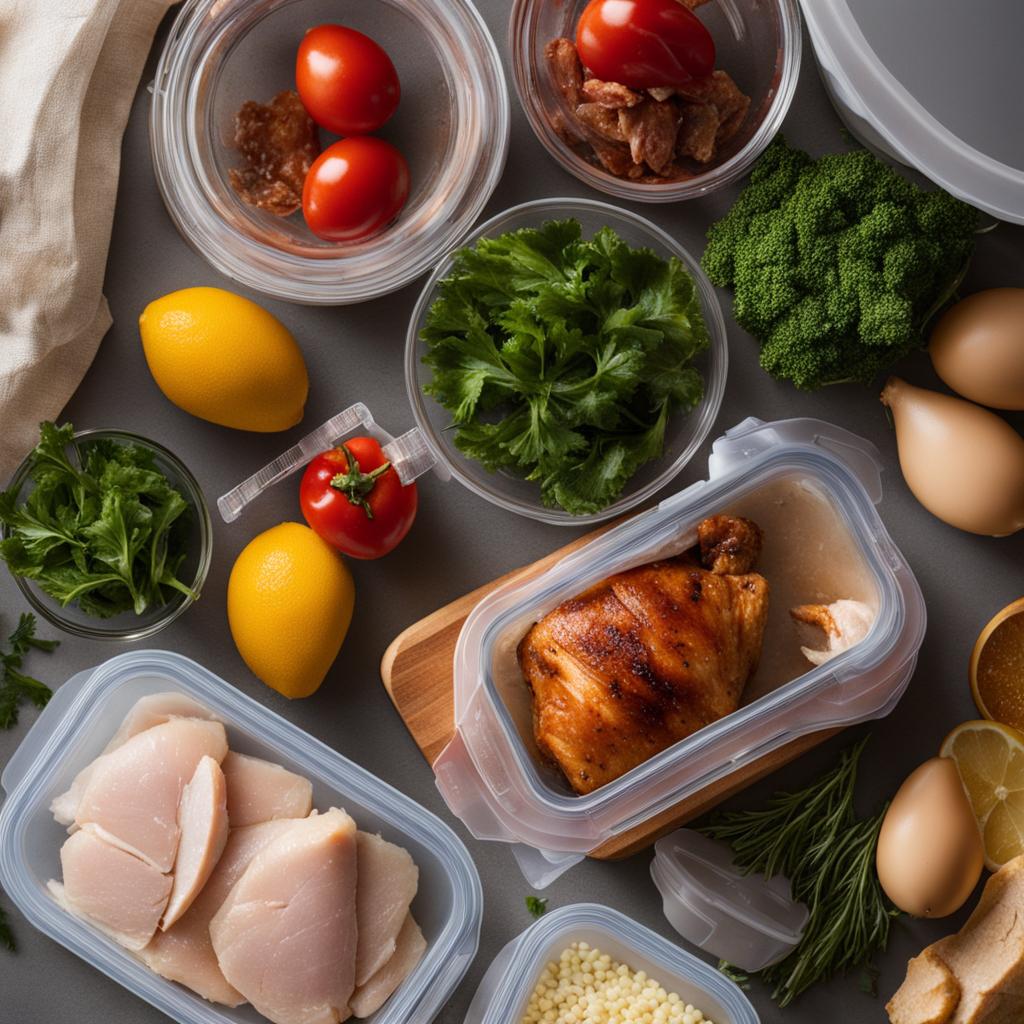
Avoiding Common Mistakes in Chicken Storage
When it comes to storing chicken, there are some common mistakes that can compromise food safety. By being aware of these mistakes and taking the necessary precautions, you can ensure that the chicken you store remains fresh and safe for consumption.
One of the most common mistakes is leaving cooked chicken at room temperature for too long. Bacteria can multiply rapidly at temperatures between 40°F and 140°F, increasing the risk of foodborne illnesses. It is important to promptly refrigerate cooked chicken to prevent bacterial growth.
Another mistake to avoid is storing raw chicken above or next to ready-to-eat foods. Raw chicken can contain harmful bacteria such as Salmonella or Campylobacter, which can cross-contaminate other foods and lead to foodborne illnesses. Always store raw chicken on the bottom shelf of the refrigerator or in a separate compartment to prevent any dripping or contact with other foods.
Properly cooling raw chicken during transportation is also crucial. If you are transporting raw chicken from the grocery store, make sure to keep it in a cooler with ice packs to maintain a safe temperature. Avoid leaving raw chicken in a hot car or exposed to direct sunlight, as this can promote bacterial growth.
Common Mistakes in Chicken Storage:
- Leaving cooked chicken at room temperature for too long
- Storing raw chicken above or next to ready-to-eat foods
- Improperly cooling raw chicken during transportation
By avoiding these common mistakes and following proper chicken storage guidelines, you can minimize the risk of foodborne illnesses and ensure the safety of the chicken you consume. Always prioritize food safety and handle raw and cooked chicken with care.
Conclusion
Properly storing chicken is essential for food safety. By following these guidelines, you can ensure the freshness and quality of both raw and cooked chicken, while also preventing the growth of harmful bacteria and foodborne illnesses.
Remember to refrigerate raw chicken at temperatures below 40°F, and use the refrigerator for short-term storage of up to 1 to 2 days. For long-term storage, freezing is recommended. Wrap individual pieces in foil or plastic bags and place them in a larger freezer bag or wrap to prevent freezer burn. Raw chicken can be stored in the freezer for 3 to 4 months, depending on the type.
When it comes to cooked chicken, refrigerate leftovers promptly, storing them in the refrigerator for 3 to 4 days. Alternatively, you can freeze cooked chicken in an airtight container for 4 to 6 months. However, keep in mind that different types of cooked chicken may have varying storage times.
By maintaining proper hygiene, using suitable storage containers, and adhering to the correct temperatures for storage, you can ensure that your chicken remains safe and of the highest quality. So remember, whether you’re storing raw chicken or cooked chicken, always prioritize food safety to keep yourself and your loved ones healthy.
FAQ
How long can I store fresh raw chicken in the refrigerator?
Fresh, raw chicken can be stored in the refrigerator for 1 to 2 days.
Can I freeze raw chicken?
Yes, freezing raw chicken can extend its shelf life. Wrap individual pieces in foil or plastic bags and place them in a larger freezer bag or wrap to prevent freezer burn.
How long can I freeze raw chicken?
Raw chicken can be stored in the freezer for 3 to 4 months, depending on the type.
How long can I refrigerate cooked chicken?
Leftover cooked chicken should be stored in the refrigerator for 3 to 4 days.
Can I freeze cooked chicken?
Yes, cooked chicken can be frozen in an airtight container for 4 to 6 months.
How should I store raw chicken in the refrigerator?
Place raw chicken on the bottom shelf to prevent drippage onto other food items. Keep it away from ready-to-eat foods to avoid cross-contamination. Tightly wrap it in plastic to prevent juices from spreading.
What hygiene practices should I follow when handling raw chicken?
Wash your hands thoroughly before and after handling raw chicken. Use separate cutting boards and utensils for raw chicken to prevent cross-contamination. Clean surfaces and tools with hot, soapy water after use.
How long is raw chicken good for in the refrigerator?
Use fresh raw chicken within 1 to 2 days of refrigeration. Pay attention to expiration dates on packaged chicken. If it smells bad or has an off texture, it may be spoiled and should be discarded.
How should I freeze raw chicken to maintain its quality?
Freeze raw chicken in small portions to easily take out what you need. Flatter and smaller wrapped chicken freezes faster, preserving the quality and preventing bacterial growth.
What should I do with cooked chicken after cooking?
Do not leave cooked chicken on the countertop for more than 2 hours. Place it in the refrigerator promptly to prevent bacterial growth. Loosely cover cooked chicken for the first couple of hours to allow it to cool quickly.
What types of containers should I use to store raw chicken?
Use airtight and sealed containers, such as ziplock bags or freezer bags, to store raw chicken in the refrigerator or freezer. Alternatively, wrap chicken tightly in cling wrap or aluminum foil to prevent exposure to air and potential contamination.
What are the ideal temperatures for chicken storage?
Store raw chicken in the refrigerator at or below 40°F and keep the freezer temperature at or below 0°F for optimal storage of both raw and cooked chicken.
How should I thaw frozen chicken?
Thaw frozen chicken safely in the refrigerator or using the defrost setting on the microwave. Avoid thawing chicken at room temperature to prevent bacterial growth. Always cook thawed chicken immediately after defrosting.
What temperature should reheated cooked chicken reach?
When reheating cooked chicken, ensure it reaches a safe temperature of 165°F to kill any bacteria. Use a food thermometer to check the internal temperature. Discard any leftover reheated chicken that has been left at room temperature for more than 2 hours.
What are some tips for optimal chicken storage?
Follow these tips: keep raw and cooked chicken separate, check expiration dates, label and date freezer packages, maintain proper hygiene, and store chicken at appropriate temperatures in suitable containers.
What are common mistakes to avoid in chicken storage?
Some common mistakes include leaving cooked chicken at room temperature for too long, storing raw chicken above or next to ready-to-eat foods, and failing to cool raw chicken properly during transportation.
Source Links
- https://www.goldnplump.com/content/chicken-basics-storing-chicken
- https://www.southernliving.com/food/kitchen-assistant/chicken-storage-mistakes
- https://www.tastingtable.com/1172764/the-safest-way-to-store-raw-chicken-once-youve-opened-the-package/
Related Recipes:
 How Long Can Cooked Chicken Sit Out? Safety Tips.
How Long Can Cooked Chicken Sit Out? Safety Tips.
 How to Store Fish to Ensure Freshness
How to Store Fish to Ensure Freshness
 How Long Can Yogurt Sit Out? Guidelines and Safety
How Long Can Yogurt Sit Out? Guidelines and Safety
 How Long Can Pizza Sit Out? Safety and Storage Tips
How Long Can Pizza Sit Out? Safety and Storage Tips
 How to Store Baked Goods to Keep Them Fresh
How to Store Baked Goods to Keep Them Fresh
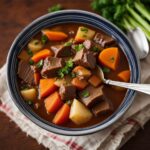 Beef Stew Shelf Life: How Long Does It Last in the Fridge?
Beef Stew Shelf Life: How Long Does It Last in the Fridge?
 How to Store Carrots? (Perfect Every Time!)
How to Store Carrots? (Perfect Every Time!)
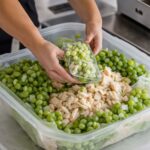 Can You Freeze Chicken Salad? Tips and Considerations
Can You Freeze Chicken Salad? Tips and Considerations


